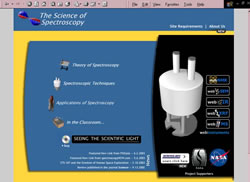|
|
Vol.
25 No. 5
September-October 2003
| Internet
Connection |
|
|
Providing
brief overviews of helpful chemistry resources on the
web. |
The
Science of Spectroscopy
www.scienceofspectroscopy.info
by
Stewart L. Mader
 Since
1999, Michael A. Rooke and Stewart L. Mader have been co-principal
investigators of The Science of Spectroscopy. Funded by NASA
through its National Space Grant College and Fellowship Program,
the project has focused on rethinking how spectroscopy is
taught in undergraduate chemistry courses. The work has resulted
in a Web-based curriculum tool that is used at a number of
colleges and universities both in the USA and abroad, including
the UK, Taiwan, Germany, and Sweden. Since
1999, Michael A. Rooke and Stewart L. Mader have been co-principal
investigators of The Science of Spectroscopy. Funded by NASA
through its National Space Grant College and Fellowship Program,
the project has focused on rethinking how spectroscopy is
taught in undergraduate chemistry courses. The work has resulted
in a Web-based curriculum tool that is used at a number of
colleges and universities both in the USA and abroad, including
the UK, Taiwan, Germany, and Sweden.
The
Science of Spectroscopy is featured in several prominent digital
libraries, including LearnNet from the Royal Society of Chemistry
<www.chemsoc.org/learnnet>
and the National Grid for Learning <www.ngfl.gov.uk>.
In addition, the journal Science recently published
a piece on the project in its Vol. 297 issue of 13 September
2002. The Science of Spectroscopy also recently became affiliated
with www.science.gov,
a U.S. government Web site dedicated to cataloging Web-based
resources sponsored by government agencies. It is the only
resource highlighting spectroscopy to be selected so far for
inclusion on the site.
Over
the past year, the site's popularity with the Asian educational
community has grown considerably. Approximately 25% of visits
now come from Pacific Rim countries by way of The Infochem
Project <http://infochem.nctu.edu.tw>,
a digital library based at the National Chiao Tung University
in Taiwan. The Science of Spectroscopy guides students through
a study of spectroscopy, beginning with an introduction to
light and its properties, the electromagnetic spectrum, types
of light both visible and invisible to the human eye, and
the effects of light interaction with matter. Students continue
to a section presenting more advanced elements of spectroscopy
theory, such as fluorescence, phosphorescence, and chemiluminescence.
The site includes descriptions of common spectroscopic analysis
techniques and applications of spectroscopy.
The
site also explains five of the most common techniques used
to study light interaction with matter. Additionally, students
can view three-dimensional molecules in a virtual reality
environment, and they can manipulate and closely inspect spectra,
the representations of data collected as a result of spectroscopic
analysis of molecules.
Another
section of the site, provides an introduction to a wide range
of spectroscopy applications: consumer devices, including
microwaves and sunscreen; medical equipment such as magnetic
resonance imaging, CT scanning, and cardiovascular imaging;
and space science technology. A special subsection of the
site focuses on NASA initiatives and missions in which spectroscopy
is a key tool. One such example is the Hubble Space Telescope,
which is highlighted for its ability to image distant nebulae,
stars, and celestial formations through the use of infrared,
ultraviolet, and visible light.
The
site's "Web Instruments" section gives students an opportunity
to interact with virtual simulations of the instruments used
to carry out spectroscopic analyses. Here students can become
familiar with the general process of preparing a sample for
analysis, collecting a set of data, and manipulating the data
to find the desired information about the sample. The newest
"Web Instrument" is a scanning electron microscope, which
provides the user a range of samples and full capability to
adjust brightness, contrast, focus, and magnification.
The
entire Web site is designed to tailor the learning experience
to the pace, schedule, and interest of the learner. It also
allows an instructor to use as much of the content as desired
in a course, and content in one section can be used either
in conjunction with, or independent of, any other section
of the site.
A
major new addition to the Web-based material provided by The
Science of Spectroscopy is the documentary Seeing the Scientific
Light, which is scheduled for release this summer.
www.scienceofspectroscopy.info
Page
last modified 3 September 2003.
Copyright © 2002-2003 International Union of Pure and
Applied Chemistry.
Questions regarding the website, please contact [email protected]
|